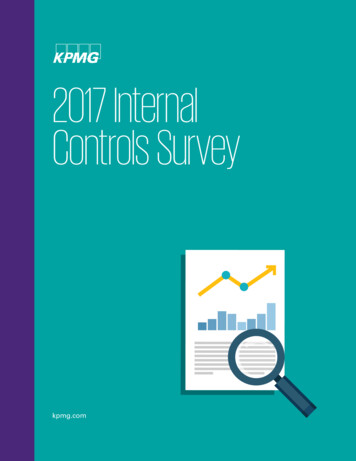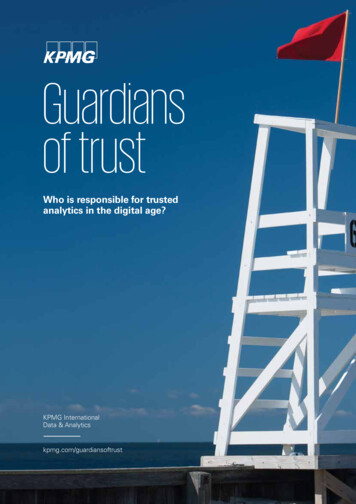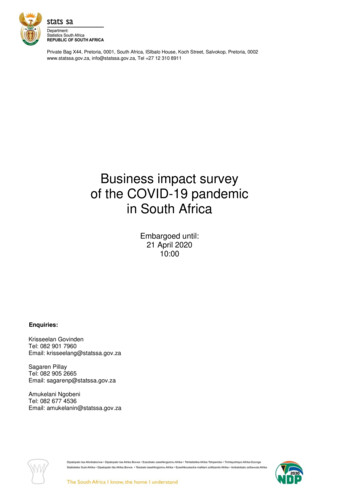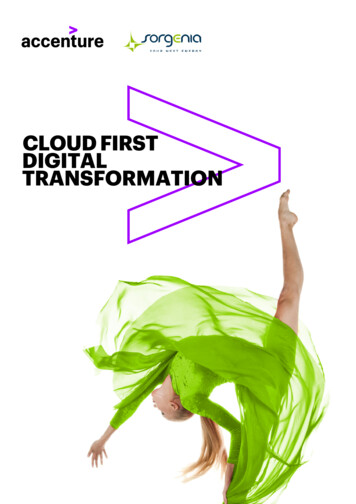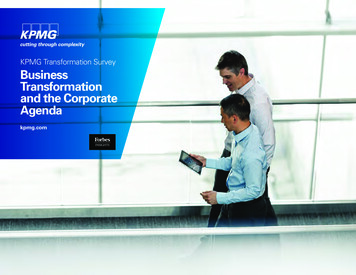
Transcription
KPMG Transformation SurveyBusinessTransformationand the CorporateAgendakpmg.com
Business transformation has takenhold across the broad corporatelandscape due to the confluence ofseveral important triggers, including atipping point in globalization, a majorslowdown in Western economies,significant shifts in technology andenergy costs, and the challenges ofregulatory compliance. 2014 KPMG LLP, a Delaware limited liability partnership and the U.S. member firm of the KPMG network of independent member firms affiliated with KPMG International Cooperative (“KPMG International”), a Swiss entity. All rights reserved. Printed in the U.S.A.
Business Transformation and the Corporate Agenda/ 01IntroductionTrends affecting business transformation are unprecedented in theirsheer number and intensity. For corporations, change has becomethe new normal, according to a KPMG survey of more than 900 seniorexecutives from U.S.-based multinationals and asset managers, as wellas one-on-one interviews with top executives.This paper explores the types of business transformations beingundertaken and the confluence of factors that triggered them. It alsoreveals how executives and thought leaders approach the strategy andexecution of a business transformation.Business transformation now has a prominent place on corporate agendas.Ninety-three percent of U.S.-based multinational companies are in somephase of changing their business models, according to KPMG research.Business transformation has taken hold across the broad corporatelandscape due to the confluence of several important triggers, includinga tipping point in globalization, a major slowdown in Western economies,significant shifts in technology and energy costs, and the challenges ofregulatory compliance.The majority of companies take a strategic approach to transformationby continually aligning their business models with strategy; the rest aresplit between those who view transformation as a wholesale turnaroundthat leads to an overhaul of the business model and those who adopt anarrower view, limiting themselves to transforming specific processes,functions or areas.Customer demand is perceived as the primary trigger for transformationby 33% of survey respondents, or the largest group. This is just a third ofall the respondents, which underscores the diversity of signals comingfrom the marketplace and the relative importance of each of them.To further underscore the complexity of the current business climate,customer demand may itself have root causes as disparate as governmentsequestration, convergence of emerging technologies or demand for amore service-oriented economy. None of these triggers is a constant,making the continuous aspect and the need for flexibility of businesstransformation solutions an imperative. 2014 KPMG LLP, a Delaware limited liability partnership and the U.S. member firm of the KPMG network of independent member firms affiliated with KPMG International Cooperative (“KPMG International”), a Swiss entity. All rights reserved. Printed in the U.S.A.ContentsBusiness transformation and thecorporate agenda . . . . . . . . . . . . . . . . . . . 02Types of business transformation . . . . . . 03Transformation triggers . . . . . . . . . . . . . . 06Conclusion . . . . . . . . . . . . . . . . . . . . . . . . 11Contributors & Methodology . . . . . . . . . . 1293%U.S.-based multinationals in some phase ofchanging their business models.
02 /Business Transformation and the Corporate AgendaBusiness transformation has a prominent place on the corporate agendaA vast majority of U.S. multinationalsare making changes, with 93% of theKPMG survey respondents sayingtheir companies are at some stage ofundergoing or preparing for transformation(Fig. 1). For top executives at multinationalcompanies, there is no other way. “Ourview is ‘transform or wither,’ ‘transform orlose pace,’” says Catherine Bessant, GlobalTechnology & Operations executive at Bankof America. Other executives agreed — infact, each of the companies profiled hereis undergoing transformation or has justcompleted such an effort.“We are living ininteresting times, with multipletransformation triggers allpresent at the same time, allequally intense.”–R obert T. VanderwerfU. S. Leader, KPMG StrategicServices GroupThis state of affairs results from two factors,explains Robert T. Vanderwerf, U. S. Leader,KPMG Strategic Services Group. “We areliving in interesting times, with multipletransformation triggers all present at thesame time, all equally intense,” he says,pointing to a tipping point in globalization, amajor slowdown in Western economies,significant shifts in technology and energycosts, and the challenges of regulatorycompliance.“When four or five significant drivers arechanging at the same time, the businessenvironment becomes highly complex,”says Vanderwerf. Additionally, as the lifespans of these trends continue to shorten,organizations need to respond with flexiblesolutions they can adapt to the nextdevelopment.Christa Carone, chief marketing officerat Xerox, agrees that change is the newnormal. “Where we are right now as anenterprise, we would actually say there isno start and stop because the market ischanging, is evolving so rapidly. We alwayshave to be aligning our business modelwith those realities in the marketplace,”she says of Xerox, which is transformingfrom a document technology to a servicescompany.FIGURE 1.Where are you on the transformation continuum?(The percentage of U.S.-based multinational companiesin some phase of changing their business models)17%14%29%27%6%7%111Not considering any transformation initiativesAssessing the need for business transformationPlanning a transformation initiativeWhat does it take to accomplish asuccessful transformation? “The rightstrategic vision, being able to anticipatewhat your customer is going to wantin the future, and leveraging new anddisruptive technologies,” says Stephen G.Hasty, a KPMG partner and U.S. Innovation111Started the implementation of transformationCompleted at least one major transformation initiativeHave completed several major transformation initiativesLeader for Advisory. Most companies getthe vision right, but the execution is thehard part: more than half of companiesundertaking transformation fail to achievethe desired business result, estimatesHasty. 2014 KPMG LLP, a Delaware limited liability partnership and the U.S. member firm of the KPMG network of independent member firms affiliated with KPMG International Cooperative (“KPMG International”), a Swiss entity. All rights reserved. Printed in the U.S.A.
Business Transformation and the Corporate Agenda/ 03Types of business transformationAccording to the KPMG survey, theapproach to transformation is mostlyongoing and strategic. The biggest group,and a majority, of respondents (51%)define transformation as a continuousprocess of aligning business model tosupport strategy (Fig. 2). The second-largest group (31%) define transformationas narrower efforts limited to specificfunctions, processes or areas, continuousor finite. Substantially fewer respondents(18%) define transformation as an all-outturnaround effort that results in an overhaulof a business model.FIGURE 2.How does your organization define transformation?5151% C ontinuous process of aligning business modelto support business strategy18% Enterprise transformation projects that involvean evaluation of a cross- section of markets,products, organizations and/or processes thatresult in a new business model17% L ocalized projects within functionsand processes14181714% C ontinuously evolving specific organizationalareas or processesAs is the case with most surveyrespondents, Bessant says thattransformation is continuous at Bankof America. “We take the perspectivethat the concept and the execution oftransformation are never complete,” shesays, “because the marketplace changes,and so do the needs of our clients andcustomers—and the digital era justaccelerates all of that.” Bessant definestransformation as non-incremental change,with a medium- to long-term vision and theexecution of that vision.Mitchell L. Siegel, Principal, FinancialServices Transformation Leader, agrees,adding “Business model assessment isa continuous improvement process andthe operating model requires ongoingrefinement to adjust to the constantlychanging marketplace dynamics.In the case of Lockheed Martin, whosebusiness is operating in a very long cycleindustry, leaders look closely at global,socioeconomic and technological macrotrends and then adapt the business tothem. “Rather than a tipping point or atrigger, we think of business transformationas a continuous process that we haveintegrated into all the components of ourcompany and how we operate,” says Dr.Ray O. Johnson, senior vice president andchief technology officer at Lockheed Martin.“We take the perspective that the concept and the executionof transformation are never complete because the marketplacechanges, and so do the needs of our clients and customers—andthe digital era just accelerates all of that.–C atherine BessantGlobal Technology & Operations ExecutiveBank of America 2014 KPMG LLP, a Delaware limited liability partnership and the U.S. member firm of the KPMG network of independent member firms affiliated with KPMG International Cooperative (“KPMG International”), a Swiss entity. All rights reserved. Printed in the U.S.A.”
04 /Business Transformation and the Corporate Agenda31%Participants who definetransformation as focusedon specific functions, areasor processesAT&T is an example of a vast and deepcontinuous transformation that hasseveral root causes: the post-acquisitionconsolidation, technology and culture.Following a decade of significantconsolidation, involving the merger ofPacific Telesis Group, Ameritech, AT&T,BellSouth and Cingular, AT&T has becomea company of huge scale but with multiplelegacy cultures, systems, processes andproducts. Chairman and CEO RandallStephenson has led AT&T through asuccessful comprehensive, strategic andcultural transformation, says Andy Geisse,CEO of AT&T Business Solutions. Thiscoincided with a strategic shift in technologyfrom wireline to mobile. To conduct thesedeep transformations, AT&T created AT&TUniversity (TU), a continuous programdedicated to changing the culture ofexecutives, including middle and frontlinemanagers.The company also established four pillarsof innovation to create an entrepreneurialmindset. Building on the 137-year heritageof the Labs, AT&T opened up its network toinnovation by making important ApplicationProgram Interfaces (APIs) available todevelopers. It also opened AT&T Foundryinnovation centers to accelerate the processof bringing new products and services tomarket, and it created a new crowdsourcingprogram, called The Innovation Pipeline (TIP)for employees to bring their ideas for newproducts and services to an online site wherethe best ideas would be built upon, fundedand brought to market. 2014 KPMG LLP, a Delaware limited liability partnership and the U.S. member firm of the KPMG network of independent member firms affiliated with KPMG InternationalCooperative (“KPMG International”), a Swiss entity. All rights reserved. Printed in the U.S.A.
Business Transformation and the Corporate Agenda/ 05Types of transformation (cont.)The second-largest group of the surveyrespondents (31%) define transformationas focused on specific functions, areas orprocesses. “All transformations would beenterprise-wide in a perfect world, whichwould allow us to harness economies ofscale,” says Steve Phillips, chief informationofficer at Avnet, a global distributor ofelectronic components, computer productsand embedded technology. “In reality,though, the scale of the transformationneeds to be determined by the requirementsand the readiness of our customers and ofthe business in each of the more than 80countries Avnet serves,” he adds.The company finds that businesstransformation works best on a regionalbasis, since Avnet’s customers buy and areserved regionally. Yet once the transformationis in place in one region, Avnet can lookat how and when it can be adapted andimplemented in other areas of the businessto meet that area’s unique needs. “However,we suspect that this [approach ] will changeover time based on the way our customersand suppliers go to market,” says Phillips.It’s easy to see why just 18% of respondentsdefine their transformation as an overhaul.This is not the type of transformation thatcompanies undertake voluntarily or honecontinuously. Put in medical terms, it’s notelective but often life-saving surgery. “It’s anear-death decision,” says Chakib Bouhdary,SAP’s chief value officer. “The platformshave to be burning.” In the case of SAP, amajor transformation was the only solution,after the company’s sales declined after thefinancial crisis in 2008.The company considered various options,including patching up its existing businessmodel, or making a huge bet on the futureand embarking on a major transformation.That last option was chosen. The result ofthe transformation was HANA, software“All transformations would be enterprise-wide in a perfectworld, which would allow us to harness economies of scale.In reality, though, the scale of the transformation needs tobe determined by the requirements and the readiness of ourcustomers and of the businesses.–S teve PhillipsChief Information Officer, Avnetthat helps companies run their business inreal-time. It is SAP’s fastest-growing productever, in terms of sales, Bouhdary says.Bouhdary draws a lesson from thecompany’s approach to transformation.“One of the biggest barriers to a successfultransformation is a leader who’s wedded toa past success,” he says. “They want to fixthings, put on patches. Customers’ needsare constantly changing. You need to adjustyour product and services to their needs. Thecustomer wants something new.”FIGURE 3.Top three triggers for transformation (across all industries)Transformation is triggered by many diverse causes, with none being considered a primary triggerby more than a third of overall respondents.33%Customer demand(changes in customer focus, buying patterns/preference)30%Coping with change in technology29%Domestic competitors” 2014 KPMG LLP, a Delaware limited liability partnership and the U.S. member firm of the KPMG network of independent member firms affiliated with KPMG International Cooperative (“KPMG International”), a Swiss entity. All rights reserved. Printed in the U.S.A.
06 /Business Transformation and the Corporate AgendaTransformation triggers: customer demandCustomer demand is perceived as theprimary trigger for transformation by 33%of the KPMG survey respondents, or thelargest group. Although it’s the largest group,it is just a third of all the respondents, whichunderscores the diversity of triggers comingfrom the marketplace and the relativeimportance of each of them (Fig. 3).The reason for such disparate answers isthat so many different and equally importanttrends are developing in the market at thesame time. To further confound matters, amajor trigger such as customer demandmay have a different underlying reason,depending on the industry, company orgeography, explains Thomas W. Whittle,audit partner at KPMG. For example, “infinancial services or healthcare, there issignificant new regulation that’s redefiningcustomer demand,” Whittle says.To answer this challenge, Lockheed Martinis refocusing product development: it’sbringing innovation to the affordabilitychallenge in the same way that, historically,the company used innovation to createenhanced capabilities for its products. Oneway is by using advances in materialstechnology to devise stronger, lighter, moreaffordable solutions. Nanotechnology, forexample, is enabling Lockheed Martinto build more affordable systems withenhanced capabilities that are also moresustainable.“Simultaneously, Lockheed Martin istransforming its processes to better servecustomers from the private sector, as thecompany is enlarging its client pool toserve more non-government customers.The company understands all aspects ofworking with governments around theworld, but was less familiar with privatemarkets. To successfully deal with privatemarkets, Lockheed Martin has put in placeInnovation Readiness Levels, to makesure that employees understand all theelements of business models in privatemarkets just as well as they understand theworkings of governments.“I’m proud to say that we are developing avery positive track record in understandingall the elements of the various businessmodels outside governments,” saysJohnson.I’m proud to say that we are developing a very positive trackrecord in understanding all the elements of the various businessmodels outside governments.–D r. Ray O. JohnsonChief Technology OfficerLockheed Martin” Lockheed MartinAs the following examples show, customerdemand may have root causes as diverseas government sequestration, convergenceof emerging technologies or demand for amore service-oriented economy.In the case of Lockheed Martin, meetingcustomer demand means responding tothe new reality of sequestration, whichis putting pressure on the company’sbiggest client, the U.S. Government, saysLockheed Martin’s Johnson. 2014 KPMG LLP, a Delaware limited liability partnership and the U.S. member firm of the KPMG network of independent member firms affiliated with KPMG International Cooperative (“KPMG International”), a Swiss entity. All rights reserved. Printed in the U.S.A.
Business Transformation and the Corporate Agenda 2014 KPMG LLP, a Delaware limited liability partnership and the U.S. member firm of the KPMG network of independent member firms affiliated with KPMG International Cooperative(“KPMG International”), a Swiss entity. All rights reserved. Printed in the U.S.A.Lockheed Martin, has put in place InnovationReadiness Levels to better serve the privatemarketplace. These help ensure that employeesunderstand all the elements of businessmodels in private markets just as well as theyunderstand the workings of governments./ 07
AT&T Business Solutions workedwith Amtrak on an end-to-end solutionthat includes cellular, Wi-Fi, satellite,cloud capability and mobile applicationcapabilities. The result is electronicticket scanning with an iPhone, digitalcheck-ins and revenue recognition.Triggers (cont.)An AT&T business customer’s demandfor an end-to-end solution was thetrigger for internal transformation.“Nobody comes in and says, ‘I just want tobuy wireline products or wireless products,”says Geisse. “They’re saying, ‘I’ve gotthis problem and need to transform mybusiness.’” Indeed, AT&T has transformedits entire self, integrating the long distanceservices, global IP network, and enterpriseclass services that were built in legacyAT&T with the wireless strengths anddomestic U.S. footprint of the former SBC.AT&T Business Solutions, the operationGeisse heads, is the company’s global unitthat leverages these capabilities for theglobal business market, meeting the needsof large global multinational and mid-marketcompanies and, in the U.S. only, smallbusinesses. AT&T’s integrated serviceshelp the business customer, who wantsto deal with one AT&T and not multipledivisions.Geisse cites the work that AT&T did forAmtrak as an example. Amtrak had a morethan-century-old process for collecting andpunching paper tickets on trains, beforehaving them validated and being able torecognize revenue.The company wanted to move to electronicticket processing and immediate revenuerecognition. AT&T Business Solutionsworked with Amtrak on an end-to-endsolution that includes cellular, Wi-Fi, satellite, 2014 KPMG LLP, a Delaware limited liability partnership and the U.S. member firm of the KPMG network of independent memberfirms affiliated with KPMG International Cooperative (“KPMG International”), a Swiss entity. All rights reserved. Printed in the U.S.A.
Business Transfor
Started the implementation of transformation. . officer at Avnet, a global distributor of electronic components, computer products and embedded technology. “In reality, though, the scale of the transformation . In the c

